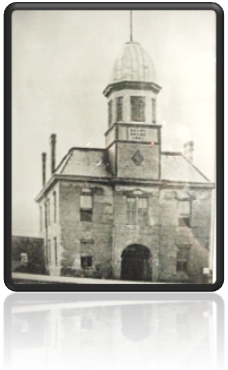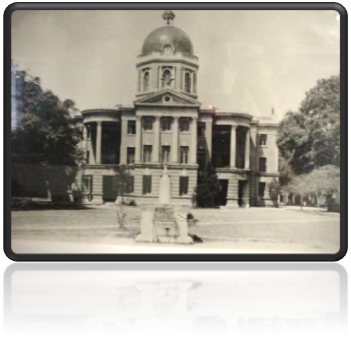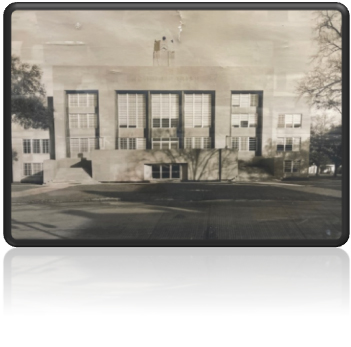History
The 1st Courthouse for Acadia Parish: 1887-1902

The 2nd Courthouse for Acadia Parish: 1902-1951
This Courthouse was built as more room was needed. It was later destroyed by fire.

The 3rd Courthouse for Acadia Parish: 1952-Present

Facts about the Dedication of the Acadia Parish Courthouse

- Construction began on or around April 3, 1950.
- Day of the Dedication was April 3, 1952, at 1:30pm on the front lawn of the Courthouse.
- Architect, TL Perrier
- Contractor, RP Farnsworth
- On that day, at least 5,000 people gathered in celebration of the dedication.
- Massed bands of Acadia High Schools played the national anthem at the foot of the flag and held a concert prior to the opening ceremonies.
- Citizens were able to tour the facility prior to the ceremony, with floral displays in each office—most of which were gifts from entities and officials throughout the parish sent as a congratulations.
- Chief Justice of the Louisiana Supreme Court, John John B. Fournet, dedicated the Courthouse.
- Blessings were given by Rev. Maurice Schexnayder, of St. Michael’s Catholic Church and by Rev. Alfred M Brown of First Methodist Church of Crowley.
- Population of Acadia parish at that time was 30,000 citizens.
Source: Crowley Daily Signal Newspaper
An article from the Daily Advertiser: August 26, 1997
“History of Acadiana”
“Rayne, Prairie Hayes, ‘Parkersonville’ wants Acadia Parish Courthouse” was the headlines for a fight to see who would get to build this Acadia Parish Courthouse.
At the time of the election to form Acadia Parish, it appeared to be a foregone conclusion that Rayne would be the new parish seat. But a funny thing happened along the way.
Ten days after the election, Eugene Hockaday, a farmer at Prairie Hayes, offered $10,000 and land to build the courthouse on his property. He threw a big picnic on October 22 to show off his land and gain support for his idea. The Rayne Signal editorialized that Hockady’s proposal was ridiculous and that, since Rayne had been most responsible for the parish formation, Rayne should be the parish seat.
Nonetheless, Hockaday’s proposal did bring about the formation of a committee to study where the courthouse should be.
The Rayne Signal continued to editorialize. On October 3o, 1886, it said: “Rayne is eminently suitable for the parish seat, its accessibility, its establishment as a trade center are facts that cannot be controverted. It is a town which is backed by a trade which is permanent as it is the natural outlet for that trade. This trade is independent of the location of the courthouse, in truth, it will hold the trade if the courthouse is located somewhere else. The other places which may be put in competition with Rayne are wholly unsuitable, because (they are) inaccessible, and bare prairies, which would depend upon Rayne as their nearest railroad depot.”
Nonetheless, the Hockaday proposal to put the courthouse in Prairie Hayes did get some support, much of it based upon the fact that it would be more centrally located in the parish.
Governor John McEnery first set January 25, 1887, as the date for an election to determine the parish seat, then changed the date to March 1, 1887, to allow more time for voter registration. It would also allow the construction of a new town to contend for the courthouse, something nobody had seemed to have thought about – except the Duson brothers.
The Abbeville Meridional reported in December 1886, “It was whispered in our ear a few days ago that while the citizens of Rayne and Prairie Hayes are discussing the question as to which place would be the most eligible point to build a courthouse for the new parish of Acadia, some parties in Opelousas are privately discussing the propriety and arranging a scheme of having it located six miles west of the former named place, and called the new town Parkersonville.”
The new town was first given the name Parkersonville in honor of J.G. Parkerson, general manager of the Louisiana Western Railroad. Parkerson later declined the honor, and the developers picked the name of another railroad man, Patrick Crowley.
The Opelousas Courier reported on December 23, 1886: “Sheriff Duson is back from New Orleans where he has been advertising the embryo town of Crowley on the Louisiana Western Railroad between Rayne and Mermentau.”
Then while others argued, the Duson’s began building. It made some of the people in Rayne nervous, but the Acadia Sentinel editorialized on January 8, 1887, that there was nothing to worry about.
“It’s true,” said the newspaper, “that if Crowley were a town or even a station, with an active, wealthy and energetic crowd of men backing it, it might become a rival. But the town exists on paper and a town is not built in a day or year either, especially in Louisiana, and it will be some years before the friends of this intended town will be justified in such ambition…At present, therefore, we see no danger in Crowley, and like every good citizen, we welcome the signs of progress on the west…”
But Crowley was growing faster than the Sentinel editor thought. The New Orleans Democrat reported on January 16, 1887, that Crowley now sported “improvements which are numerous and of a most substantial character.” The New Orleans newspaper also reported: “It is understood that Crowley will be made the parish seat of Acadia.”
By February 1887 even the Rayne editors were beginning to take Crowley seriously, as were backers of the Prairie Hayes site. At a public meeting there on February 8, a committee of local citizens endorsed Eugene Hockaday’s proposal to donate 80 acres of land and money to build the courthouse, as well as to provide the streets and drainage and donate land for any churches that would wish to come to the courthouse community. Prairie Hayes backers pointed out that it was at the geographical center of the new parish. Rayne backers bolstered their argument by taking a count and finding 14 parish seats in Louisiana that were not in geographical centers. The Southwestern Louisiana Land Co. said it would put up $5,000 to build a courthouse in Crowley, in addition to donating the land at the center of the new town.
A week before the election the editor in Rayne advised his readers to continue politicking for their town and to place “good, sober, strong men at every poll; men who won’t get drunk, or won’t sell out, and who will stick to the polls until the returns are made.”
On March 1, there were 1,777 votes cast on the courthouse issue. Crowley got 698 of them. Rayne got 560 votes. Prairie Hayes got 519.
There aren’t any contemporary sources of information on Rayne’s reaction to the loss of the courthouse. According to local tradition, however, some Rayne residents, including Mervine Kahn (then the town’s leading retailer), blamed Rayne leaders, not Crowley’s promoters. Kahn and others said that at the most crucial point in the debate, Rayne’s civic leaders could not agree on a location for the court building. One faction wanted it on the north side of town, another faction wanted it on the south.
So, there’s a little history on how your courthouse in Acadia Parish came to be. A special thanks to the Daily Advertiser for putting this add together on August 26, 1997. Other
“History of Acadiana” information was given in this release.
Last revised: 5/2/2005
Clerk's Office Information
Physical:
500 NE Court Circle
Crowley, LA 70526
Mailing:
P.O. Box 922
Crowley, LA 70527
Fax 1st Floor: (337) 783-3855
Fax 2nd Floor: (337) 788-1048
Monday-Friday 8:30am to 4:30pm
Office Location
500 NE Court Circle
Crowley, LA 70526
P.O. Box 922
Crowley, LA 70527
Phone : (337)788-8881 | Fax 1st Floor:(337) 783-3855 | Fax 2nd Floor: (337) 788-1048
Monday-Friday 8:30am to 4:30pm

